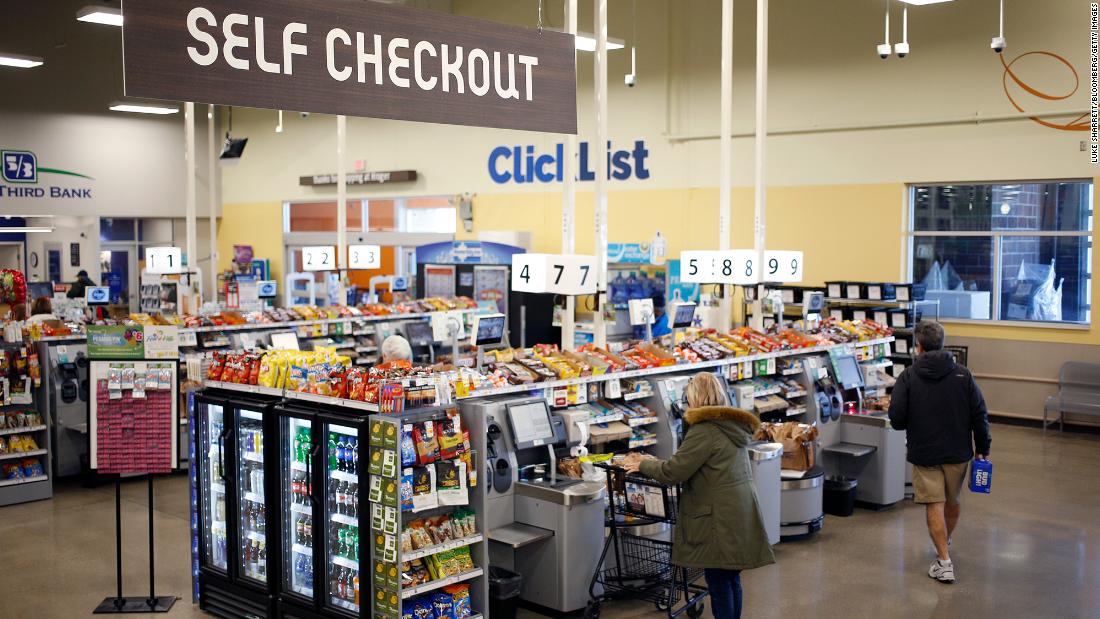
Nobody likes self-checkout. Here’s why it’s everywhere
If you have encountered these annoying alerts at the self-checkout equipment, you are not alone.
Shoppers aren’t the only ones annoyed with the self-checkout working experience. Merchants have troubles with it, also.
In spite of the headaches, self-checkout is increasing.
In 2020, 29{ac23b82de22bd478cde2a3afa9e55fd5f696f5668b46466ac4c8be2ee1b69550} of transactions at meals retailers were being processed by means of self-checkout, up from 23{ac23b82de22bd478cde2a3afa9e55fd5f696f5668b46466ac4c8be2ee1b69550} the 12 months prior, according to the most up-to-date details from food items field affiliation FMI.
This raises the query: why is this usually problematic, unloved know-how getting around retail?
Earning buyers do the perform
Instead of clerks behind a counter collecting goods for shoppers, Piggly Wiggly authorized purchasers to roam the aisles, pick objects off the shelves and fork out at the sign up. In trade for carrying out a lot more work, the design promised lessen prices.
Self-checkout, having said that, was built largely to lessen stores’ labor costs. The system minimized cashier fees by as a great deal as 66{ac23b82de22bd478cde2a3afa9e55fd5f696f5668b46466ac4c8be2ee1b69550}, in accordance to a 1988 posting in the Miami Herald.
The initial fashionable self-checkout program, which was patented by Florida company CheckRobot and set up at a number of Kroger retailers, would be just about unrecognizable to customers these days.
Prospects scanned their goods and set them on a conveyor belt. An employee at the other close of the belt bagged the groceries. Prospects then took them to a central cashier spot to pay back.
But self-checkout did not revolutionize the grocery shop. Quite a few clients balked at possessing to do more perform in exchange for benefits that were not entirely apparent.
“The rationale was economics based, and not centered on the purchaser,” Charlebois claimed. “From the get go, clients detested them.”
A 2003 Nielsen study found that 52{ac23b82de22bd478cde2a3afa9e55fd5f696f5668b46466ac4c8be2ee1b69550} of purchasers deemed self checkout lanes to be “okay,” while 16{ac23b82de22bd478cde2a3afa9e55fd5f696f5668b46466ac4c8be2ee1b69550} claimed they have been “irritating.” Thirty-two p.c of shoppers named them “excellent.”
Walkaways
The shift to self-checkout has created unintended implications for outlets as perfectly.
Even though self-checkout counters eradicated some of the tasks of classic cashiers, they nonetheless wanted to be staffed and designed a require for larger wage IT employment, he reported.
Self-checkout, Andrews included, “provides none of what it promises.”
In the greatest headache for keep house owners, self-checkout leads to far more losses thanks to mistake or theft than common cashiers.
“If you had a retail retail outlet exactly where 50{ac23b82de22bd478cde2a3afa9e55fd5f696f5668b46466ac4c8be2ee1b69550} of transactions were as a result of self checkout, losses would be 77{ac23b82de22bd478cde2a3afa9e55fd5f696f5668b46466ac4c8be2ee1b69550} bigger” than typical, in accordance to Adrian Beck, an emeritus professor at the College of Leicester in the Uk who scientific tests retail losses.
Customers make genuine errors as properly as intentionally steal at self-checkout machines.
Some products have many barcodes or barcodes that will not scan properly. Deliver, such as fruit and meat, ordinarily requires to be weighed and manually entered into the technique employing a code. Consumers might form in the erroneous code by accident. Other situations buyers would not listen to the “beep” confirming an product has been scanned effectively.
“Shoppers are not incredibly very good at scanning reliably,” Beck mentioned. “Why should they be? They are not experienced.”
Stores have tried to restrict losses by tightening self-checkout safety features, these types of as incorporating bodyweight sensors. But further anti-theft steps also guide to much more frustrating “unexpected merchandise in the bagging region” errors, necessitating store staff to intervene.
“You can find a delicate equilibrium amongst security and customer ease,” Beck mentioned.
Self-checkout is right here to continue to be
Irrespective of self-checkout’s a lot of shortcomings for buyers and retail store entrepreneurs, the pattern is only developing.
It may possibly just be much too late for stores to turn their again on self-checkout.
Shops right now are catering to shoppers who perceive self-checkout to be faster than common cashiers, even though there is small evidence to aid that. But, for the reason that consumers are carrying out the operate, instead than ready in line, the practical experience can come to feel like it is relocating much more promptly.
Shop entrepreneurs have also seen rivals installing self-checkout and established they don’t want to miss out on out.
“It is an arms race. If anyone else is performing it, you glimpse like an fool if you don’t have it,” said David D’Arezzo, a previous government at Greenback Common, Wegmans and other stores. “The moment you permit it out of the bag, it is fairly challenging not to supply it any more.”
Covid-19 has also hastened the distribute of self-checkout.
During the pandemic, many buyers opted for self-provider to avoid near interactions with cashiers and baggers. And problems selecting and retaining personnel have led merchants to depend on the devices a lot more intensely to get buyers as a result of the doorway.
